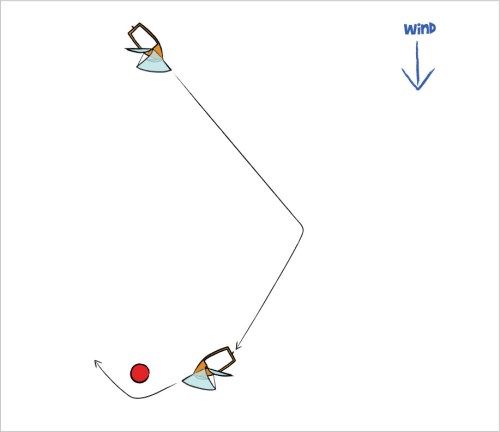Introduction to Asymmetric Spinnakers
Go To: Sailing - Techniques and Manoevres
Posted on 06 June 2009 18:25
Asymmetric spinnakers are easier to handle than their older counterpart, but they do require a different approach to sailing them.
Asymmetric spinnakers are basically huge genoa’s with a very full shape – a very large jib shaped sail that goes from the front of the boat to somewhere back of the mast. Instead of catching the wind from behind the boat, to sail downwind like symmetric spinnakers, asymmetric ones use the lift principal like normal sails, when sailed across the wind.

Sailing downwind with an asymmetric spinnaker
As a “regular” sail shape, they have a head, tack and clew. The tack is attached to the bowsprit; instead of using a spinnaker pole, asymmetric spinnakers usually have a bowsprit, which is a long pole that extends out of the front of the boat – they are usually 6 feet or longer, and usually sit inside the hull until the spinnaker is hoisted, at which point they are pulled out of the front of the boat with a pole launching system. The bowsprit extends the tack of the sail out in front of the boat.
The head of the sail can be attached in one of two places – many asymmetric spinnakers are attached just above the jib, whereas some, known as mast head spinnakers, hoist all the way to the top of the mast to catch even more wind (found on the Laser SB3 or the 49er).
The clew of the asymmetric spinnaker is attached to (usually) a continuous spinnaker sheet, and this moves from side to side (very much like the clew of a jib).
This different rigging arrangement makes an asymmetric spinnaker much easier to fly – when the boat gybes, a quick tug is usually all that’s required to gybe the spinnaker from one side of the boat to the other.
When flying an asymmetric spinnaker, the boat will not sail a downwind course, as it’s quite slow and inefficient with an asymmetric spinnaker – they are actually designed to be sailed across the wind, on a reach. This isn’t a very efficient course, however the extra speed the boat picks up more than makes up for it. On this course, an asymmetric boat will absolutely fly if the wind is up, and beat a similar boat sailing downwind without a spinnaker, particularly when “apparent wind” sailing, which we will cover in a later article.
To make things even more confusing, you can also get Code 0 asymmetric spinnakers, which are shaped and designed to be used for sailing upwind, believe it or not!